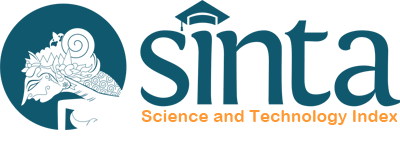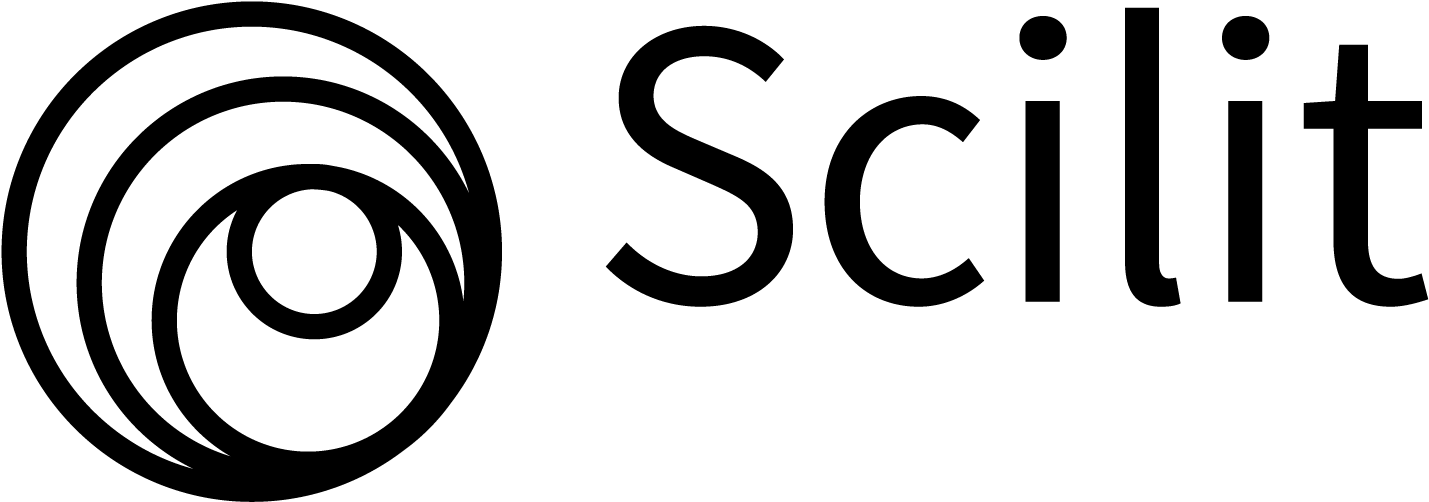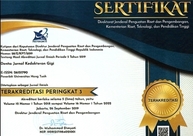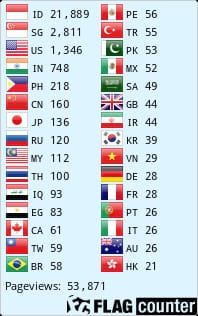Perbedaan Kitosan Berat Molekul Rendah dan Tinggi Terhadap Jumlah Sel Limfosit pada Proses Penyembuhan Luka Pencabutan Gigi
Keywords:
Chitosan, molecular weight, lymphocyte cell, wound healingAbstract
Background: Molecular weight is one of the chitosan characteristic that affects the effectiveness application for wound healing of dental extraction. Chitosan could improve wound healing process because of its anti inflammation property and improve proliferation phase. Lymphocyte cell is one of the main cells that act during inflammatory phase. Purpose: the aim of this experiment is to account lymphocyte cell in wound healing of dental extraction using chitosan with different molecular weight. Materials and Methods: 54 Male Rattus Norvegicus were divided into 3 groups. Group I is control group (without chitosan). Group II
was given low molecular weight chitosan. Group III was given high molecular weight chitosan. Rats were sacrificed by decapitation on day 5 and day 7 post extraction then they were examined histopatologically to see the change in lymphocyte cell number. Result: Data were statistically analyzed with One Way ANOVA and LSD with degree of significant p< 0,05 showed significant difference between high molecular weight chitosan group and low molecular weight chitosan group after 5 and 7 days observation. Conclusion: High molecular weight chitosan was found more effective to decrease lymphocyte cell amounts more than low molecular weight chitosan in wound healing of dental extraction process.
Downloads
References
Gosain A, DiPietro LA. 2004. Aging and Wound Healing. World J Surg, 28: 326321.
Guo S, Dipietro LA. 2010. Factors affecting Wound Healing. J Dent Res, 89(3): 229-219.3. Djamaluddin AM. 2009. Pemanfaatan
Khitosan dari Limbah Krustasea untuk Penyembuhan Luka pada Mencit (Musmusculus albinus). Skripsi, Institut Pertanian Bogor, Bogor. H. 8.
Farina R, Trombelli L. 2011. Wound healing of extraction sockets. EndodonticTopics. Dentistry & Oral Sciences Source, Ipswich, MA, 25(1): 43-16.
Budianto B. 2013. Pengaruh Kitosan Gel1% yang Memiliki Berat Molekul Tinggi dan Rendah Terhadap Jumlah Sel Osteoblas pada Proses Penyembuhan Luka Pencabutan Gigi. Skirpsi, Universitas Hang Tuah, Surabaya. H. 38,22.
Steiner GG, Francis W, Burrell R, Kallet MP, Steiner DM, Macias R. 2008. The Healing Socket And Socket Regeneration. Available from
www.Endoexperience.com/userfiles/file/unnamed/The%20Healing%20Socket%20And%20Socket%20Regeneration.pdf.
Ayu DA. 2011. Kesehatan Gingiva pada Pengguna Gigi Tiruan Cekat di Pulang Kodingareng. Skripsi. Fakultas Kedokteran Gigi Universitas Hasanuddin. Makassar. Available from http://repository.unhas.ac.id/handle/123456. Diakses 9 September 2013.
Chawaf BA. 2011. Healing of human extraction sockets augmented with BioOss Collagen after 6 and 12 weeks. Dissertation, Universitätsmedizin Berlin. P.8-1.
Sularsih. 2011. Penggunaan Kitosan dalam Proses Penyembuhan Luka Pencabutan Gigi Rattus Norvegicus. Tesis, Universitas Airlangga, Surabaya. H. 48-42.
Budi hargono O, Yuliati A, dan Rianti D. 2013. Peningkatan Mobilisasi Sel Polimorfonuklear Setelah Pemberian Gel
Kitosan 1% pada Luka Pencabutan Gigi Cavia Cobaya. Material Dental Journal Universitas Airlangga January: 6-1.
Alsarra IA. 2009. Chitosan Topical Gel Formulation in the Management of Burn Wounds. International Journal of Biological Macromolecules, 45: 21-16.
Prashanth RN, Tharanathan H. 2007. Chitin/Chitosan: Modifications and Their Unlimited Application Potential an
Overview. Trends in Food Science & Technology 18, 117131.
Kim F. 2004 . Physicochemical and Functional Properties of Crawfish Chitosan as Affected by DifferentProcessing Protocols. Thesis, Lousiana State University. H. 7-6.
Dai T, et al. 2011. Chitosan Preparations for Wounds and Burns: antimicrobial and Wound Healing Effects. Expert Rev Anti
Infect Ther, 9(7):879- 857.
Chattopadhyay DP and Inamdar MS. 2012. Studies on Synthesis, Characterization and Viscosity Behaviour of Nano Chitosan. Res. J. Engineering Sci., 1(4), 15-9.
Maeda Y, Kimura Y. 2004. Antitumor Effects of Various LowMolecular-Weight Chitosans Are Due to Increased Natural Killer Activity of Intestinal Intraepithelial Lymphocytes in Sarcoma 180– Bearing Mice. J. Nutr. 134: 950–945.
Suryadi IA, Asmarajaya AAGN, Maliawan S. 2013. Proses Penyembuhan dan Penanganan Luka. Bagian/SMF Ilmu Penyakit Bedah Fakultas Kedokteran Universitas Udayana/Rumah Sakit Umum Pusat Sanglah Denpasar. Available from http://ojs.unud.ac.id/index.php/eum/articl
e/download/4885/3671. Diakses 26 Juni 2013.
Agramula G. 2008. Aktivitas Sediaan Salep Ekstrak Batang Pohon Pisang Ambon (Musa paradisiaca var sapientum) dalam Proses Persembuhan Luka Mencit. Skripsi. Institut Pertanian Bogor. http://repository.ipb.ac.id/handle/123456789/3352. Diakses 25 September 2013. H.46.
Ariani MD, Yuliati A, Adiarto T. 2009. Toxicity Testing of Chitosan from Tiger Prawn Shell Waste on Cell Culture. Dent.
J. (Maj. Ked. Gigi), 42(1): 20-15.20. Pierce S. 2006. Euthanasia of Mice and Rats. P.1. Available from http://www.bu.edu/orccommittees/iacuc/p
olicies-andguidelines/euthanasia-ofrodents/. Diakses 29 Juli 2013.
Albert. 2011. Pengaruh Konsentrasi H202 dan Konsentrasi Asam Asetat dalam Proses Pembuatan Kitosan. Skripsi, Universitas Sumatra Utara, Medan. Available from http://repository.usu.ac.id/handle/123456789/29148. Diakses 9 Juni 2013.
Aranaz I, Mengíbar M, Harris R, Paños I, Miralles B, Acosta N, Galed G dan Heras Á. 2009. Functional Characterization of Chitin and Chitosan. Current Chemical Biology, 3: 230-203.
Larjava H. 2012. Oral Wound Healing : Cell Biology and Clinical Management. Oxford: Wiley-Blackwell. P. 47.
Freier T, Koh HS, Kazazian K, Shoichet MS. 2005. Controlling cell adhesion and degradation of chitosan films by Nacetylation. Biomaterials
:5878-5872.
Mori T, Murakami M, Okumura M, Kadosawa T, Uede T, Fujinaga T. 2005. Mechanism of Macrophage Activation by Chitin Derivates. J. Vet. Med. Sci., 67(1):56-51.
Kumar V, Abbas AK, dan Aster JC. 2011. Robbins Basic Pathology. 9th Ed. Philadelphia: Elsevier Saunders. P. 72-29.
Alemdaroglu C, Degim Z, Celebi N, Zor F, Ozturk S, Erdogan D. 2006. An investigation on burn wound healing in rats with chitosan gel formulation containing epidermal growth factor. Burns, 32: 319-32.
Downloads
Published
How to Cite
Issue
Section
License
Copyright (c) 2015 DENTA

This work is licensed under a Creative Commons Attribution-ShareAlike 4.0 International License.
Dengan menggunakan Hak Lisensi (sebagaimana didefinisikan di bawah), Anda menerima dan setuju untuk terikat oleh syarat dan ketentuan Lisensi Publik Internasional Creative Commons Atribusi-BerbagiSerupa 4.0 ini ("Lisensi Publik"). Sejauh Lisensi Publik ini dapat diartikan sebagai suatu kontrak, Anda diberikan Hak Lisensi dengan mempertimbangkan penerimaan Anda terhadap syarat dan ketentuan ini, dan Pemberi Lisensi memberikan Anda hak tersebut dengan mempertimbangkan manfaat yang diterima Pemberi Lisensi dari penyediaan Materi Berlisensi berdasarkan syarat dan ketentuan ini.
Bagian 1 – Definisi.
- Materi Adaptasi berarti materi yang tunduk pada Hak Cipta dan Hak Serupa yang berasal dari atau berdasarkan Materi Berlisensi dan di mana Materi Berlisensi tersebut diterjemahkan, diubah, disusun, ditransformasi, atau dimodifikasi dengan cara lain yang memerlukan izin berdasarkan Hak Cipta dan Hak Serupa yang dimiliki oleh Pemberi Lisensi. Untuk tujuan Lisensi Publik ini, jika Materi Berlisensi berupa karya musik, pertunjukan, atau rekaman suara, Materi Adaptasi selalu diproduksi di mana Materi Berlisensi tersebut disinkronkan dalam hubungan waktu dengan gambar bergerak.
- Lisensi Adaptor berarti lisensi yang Anda terapkan pada Hak Cipta dan Hak Serupa dalam kontribusi Anda pada Materi Adaptasi sesuai dengan syarat dan ketentuan Lisensi Publik ini.
- Lisensi Kompatibel BY-SA berarti lisensi yang tercantum di creativecommons.org/compatiblelicenses , yang disetujui oleh Creative Commons sebagai padanan hakiki dari Lisensi Publik ini.
- Hak Cipta dan Hak Serupa berarti hak cipta dan/atau hak serupa yang berkaitan erat dengan hak cipta, termasuk, namun tidak terbatas pada, hak pertunjukan, hak siaran, hak rekaman suara, dan Hak Basis Data Sui Generis, tanpa memperhatikan bagaimana hak tersebut diberi label atau dikategorikan. Untuk tujuan Lisensi Publik ini, hak-hak yang disebutkan dalam Pasal 2(b)(1)-(2) bukan merupakan Hak Cipta dan Hak Serupa.
- Langkah-Langkah Teknologi yang Efektif berarti langkah-langkah yang, jika tidak ada kewenangan yang tepat, tidak dapat dielakkan berdasarkan hukum yang memenuhi kewajiban berdasarkan Pasal 11 Perjanjian Hak Cipta WIPO yang diadopsi pada tanggal 20 Desember 1996, dan/atau perjanjian internasional serupa.
- Pengecualian dan Batasan berarti penggunaan wajar, perlakuan wajar, dan/atau pengecualian atau batasan lain terhadap Hak Cipta dan Hak Serupa yang berlaku untuk penggunaan Anda atas Materi Berlisensi.
- Elemen Lisensi berarti atribut lisensi yang tercantum dalam nama Lisensi Publik Creative Commons. Elemen Lisensi dari Lisensi Publik ini adalah Atribusi dan Berbagi Serupa.
- Materi Berlisensi berarti karya seni atau sastra, basis data, atau materi lain yang kepadanya Pemberi Lisensi menerapkan Lisensi Publik ini.
- Hak Berlisensi berarti hak yang diberikan kepada Anda sesuai dengan syarat dan ketentuan Lisensi Publik ini, yang terbatas pada semua Hak Cipta dan Hak Serupa yang berlaku untuk penggunaan Anda atas Materi Berlisensi dan yang Pemberi Lisensi berwenang untuk melisensikannya.
- Pemberi lisensi berarti individu atau badan yang memberikan hak berdasarkan Lisensi Publik ini.
- Berbagi berarti menyediakan materi kepada publik melalui cara atau proses apa pun yang memerlukan izin berdasarkan Hak Lisensi, seperti reproduksi, tampilan publik, pertunjukan publik, distribusi, penyebaran, komunikasi, atau impor, dan menyediakan materi kepada publik termasuk dengan cara yang memungkinkan anggota publik mengakses materi tersebut dari suatu tempat dan pada waktu yang mereka pilih sendiri.
- Hak Basis Data Sui Generis berarti hak-hak selain hak cipta yang timbul dari Direktif 96/9/EC Parlemen Eropa dan Dewan tanggal 11 Maret 1996 tentang perlindungan hukum basis data, sebagaimana telah diubah dan/atau digantikan, serta hak-hak lain yang pada hakikatnya setara di mana pun di dunia.
- Anda berarti individu atau entitas yang menjalankan Hak Lisensi berdasarkan Lisensi Publik ini. "Anda" memiliki arti yang sesuai.
Bagian 2 – Ruang Lingkup.
- Pemberian lisensi .
- Tunduk pada syarat dan ketentuan Lisensi Publik ini, Pemberi Lisensi dengan ini memberikan Anda lisensi yang berlaku di seluruh dunia, bebas royalti, tidak dapat disublisensikan, tidak eksklusif, dan tidak dapat dibatalkan untuk melaksanakan Hak Lisensi dalam Materi Berlisensi untuk:
- memperbanyak dan Membagikan Materi Berlisensi, secara keseluruhan atau sebagian; dan
- memproduksi, memperbanyak, dan Berbagi Materi yang Diadaptasi.
- Exceptions and Limitations. For the avoidance of doubt, where Exceptions and Limitations apply to Your use, this Public License does not apply, and You do not need to comply with its terms and conditions.
- Term. The term of this Public License is specified in Section 6(a).
- Media and formats; technical modifications allowed. The Licensor authorizes You to exercise the Licensed Rights in all media and formats whether now known or hereafter created, and to make technical modifications necessary to do so. The Licensor waives and/or agrees not to assert any right or authority to forbid You from making technical modifications necessary to exercise the Licensed Rights, including technical modifications necessary to circumvent Effective Technological Measures. For purposes of this Public License, simply making modifications authorized by this Section 2(a)(4) never produces Adapted Material.
- Downstream recipients.
- Offer from the Licensor – Licensed Material. Every recipient of the Licensed Material automatically receives an offer from the Licensor to exercise the Licensed Rights under the terms and conditions of this Public License.
- Additional offer from the Licensor – Adapted Material. Every recipient of Adapted Material from You automatically receives an offer from the Licensor to exercise the Licensed Rights in the Adapted Material under the conditions of the Adapter’s License You apply.
- No downstream restrictions. You may not offer or impose any additional or different terms or conditions on, or apply any Effective Technological Measures to, the Licensed Material if doing so restricts exercise of the Licensed Rights by any recipient of the Licensed Material.
- No endorsement. Nothing in this Public License constitutes or may be construed as permission to assert or imply that You are, or that Your use of the Licensed Material is, connected with, or sponsored, endorsed, or granted official status by, the Licensor or others designated to receive attribution as provided in Section 3(a)(1)(A)(i).
- Tunduk pada syarat dan ketentuan Lisensi Publik ini, Pemberi Lisensi dengan ini memberikan Anda lisensi yang berlaku di seluruh dunia, bebas royalti, tidak dapat disublisensikan, tidak eksklusif, dan tidak dapat dibatalkan untuk melaksanakan Hak Lisensi dalam Materi Berlisensi untuk:
-
Other rights.
- Moral rights, such as the right of integrity, are not licensed under this Public License, nor are publicity, privacy, and/or other similar personality rights; however, to the extent possible, the Licensor waives and/or agrees not to assert any such rights held by the Licensor to the limited extent necessary to allow You to exercise the Licensed Rights, but not otherwise.
- Patent and trademark rights are not licensed under this Public License.
- To the extent possible, the Licensor waives any right to collect royalties from You for the exercise of the Licensed Rights, whether directly or through a collecting society under any voluntary or waivable statutory or compulsory licensing scheme. In all other cases the Licensor expressly reserves any right to collect such royalties.
Section 3 – License Conditions.
Your exercise of the Licensed Rights is expressly made subject to the following conditions.
-
Attribution.
-
If You Share the Licensed Material (including in modified form), You must:
- retain the following if it is supplied by the Licensor with the Licensed Material:
- identification of the creator(s) of the Licensed Material and any others designated to receive attribution, in any reasonable manner requested by the Licensor (including by pseudonym if designated);
- a copyright notice;
- a notice that refers to this Public License;
- a notice that refers to the disclaimer of warranties;
- a URI or hyperlink to the Licensed Material to the extent reasonably practicable;
- indicate if You modified the Licensed Material and retain an indication of any previous modifications; and
- indicate the Licensed Material is licensed under this Public License, and include the text of, or the URI or hyperlink to, this Public License.
- retain the following if it is supplied by the Licensor with the Licensed Material:
- You may satisfy the conditions in Section 3(a)(1) in any reasonable manner based on the medium, means, and context in which You Share the Licensed Material. For example, it may be reasonable to satisfy the conditions by providing a URI or hyperlink to a resource that includes the required information.
- If requested by the Licensor, You must remove any of the information required by Section 3(a)(1)(A) to the extent reasonably practicable.
-
- ShareAlike.
In addition to the conditions in Section 3(a), if You Share Adapted Material You produce, the following conditions also apply.
- The Adapter’s License You apply must be a Creative Commons license with the same License Elements, this version or later, or a BY-SA Compatible License.
- You must include the text of, or the URI or hyperlink to, the Adapter's License You apply. You may satisfy this condition in any reasonable manner based on the medium, means, and context in which You Share Adapted Material.
- You may not offer or impose any additional or different terms or conditions on, or apply any Effective Technological Measures to, Adapted Material that restrict exercise of the rights granted under the Adapter's License You apply.
Section 4 – Sui Generis Database Rights.
Where the Licensed Rights include Sui Generis Database Rights that apply to Your use of the Licensed Material:
- for the avoidance of doubt, Section 2(a)(1) grants You the right to extract, reuse, reproduce, and Share all or a substantial portion of the contents of the database;
- if You include all or a substantial portion of the database contents in a database in which You have Sui Generis Database Rights, then the database in which You have Sui Generis Database Rights (but not its individual contents) is Adapted Material, including for purposes of Section 3(b); and
- You must comply with the conditions in Section 3(a) if You Share all or a substantial portion of the contents of the database.
For the avoidance of doubt, this Section 4 supplements and does not replace Your obligations under this Public License where the Licensed Rights include other Copyright and Similar Rights.
Section 5 – Disclaimer of Warranties and Limitation of Liability.
- Unless otherwise separately undertaken by the Licensor, to the extent possible, the Licensor offers the Licensed Material as-is and as-available, and makes no representations or warranties of any kind concerning the Licensed Material, whether express, implied, statutory, or other. This includes, without limitation, warranties of title, merchantability, fitness for a particular purpose, non-infringement, absence of latent or other defects, accuracy, or the presence or absence of errors, whether or not known or discoverable. Where disclaimers of warranties are not allowed in full or in part, this disclaimer may not apply to You.
- To the extent possible, in no event will the Licensor be liable to You on any legal theory (including, without limitation, negligence) or otherwise for any direct, special, indirect, incidental, consequential, punitive, exemplary, or other losses, costs, expenses, or damages arising out of this Public License or use of the Licensed Material, even if the Licensor has been advised of the possibility of such losses, costs, expenses, or damages. Where a limitation of liability is not allowed in full or in part, this limitation may not apply to You.
- The disclaimer of warranties and limitation of liability provided above shall be interpreted in a manner that, to the extent possible, most closely approximates an absolute disclaimer and waiver of all liability.
Section 6 – Term and Termination.
- This Public License applies for the term of the Copyright and Similar Rights licensed here. However, if You fail to comply with this Public License, then Your rights under this Public License terminate automatically.
-
Where Your right to use the Licensed Material has terminated under Section 6(a), it reinstates:
- automatically as of the date the violation is cured, provided it is cured within 30 days of Your discovery of the violation; or
- upon express reinstatement by the Licensor.
- For the avoidance of doubt, the Licensor may also offer the Licensed Material under separate terms or conditions or stop distributing the Licensed Material at any time; however, doing so will not terminate this Public License.
- Sections 1, 5, 6, 7, and 8 survive termination of this Public License.
Bagian 7 – Syarat dan Ketentuan Lainnya.
- Pemberi Lisensi tidak akan terikat oleh ketentuan atau persyaratan tambahan atau berbeda yang dikomunikasikan oleh Anda kecuali disetujui secara tegas.
- Segala pengaturan, kesepahaman, atau perjanjian mengenai Materi Berlisensi yang tidak dinyatakan di sini terpisah dari dan independen dari syarat dan ketentuan Lisensi Publik ini.
Bagian 8 – Interpretasi.
- Untuk menghindari keraguan, Lisensi Publik ini tidak, dan tidak akan ditafsirkan untuk, mengurangi, membatasi, mengekang, atau memaksakan ketentuan pada penggunaan Materi Berlisensi yang secara sah dapat dilakukan tanpa izin berdasarkan Lisensi Publik ini.
- Sedapat mungkin, jika ada ketentuan dalam Lisensi Publik ini yang dianggap tidak dapat diberlakukan, ketentuan tersebut akan secara otomatis direformasi hingga batas minimum yang diperlukan agar dapat diberlakukan. Jika ketentuan tersebut tidak dapat direformasi, ketentuan tersebut akan dihapus dari Lisensi Publik ini tanpa memengaruhi keberlakuan syarat dan ketentuan lainnya.
- Tidak ada syarat atau ketentuan Lisensi Publik ini yang akan diabaikan dan tidak ada kegagalan untuk mematuhi yang disetujui kecuali disetujui secara tegas oleh Pemberi Lisensi.
- Tidak ada satu pun dalam Lisensi Publik ini yang merupakan atau boleh ditafsirkan sebagai pembatasan atau pengesampingan hak istimewa dan kekebalan apa pun yang berlaku bagi Pemberi Lisensi atau Anda, termasuk dari proses hukum di yurisdiksi atau otoritas mana pun.











